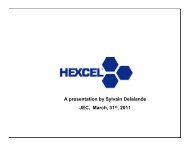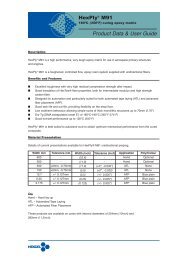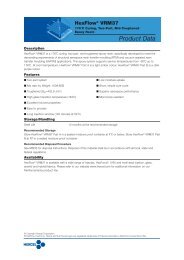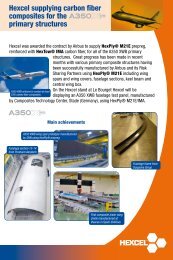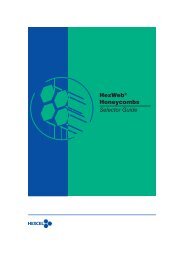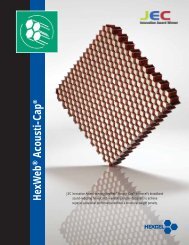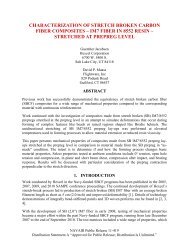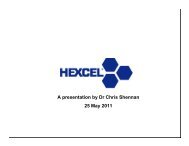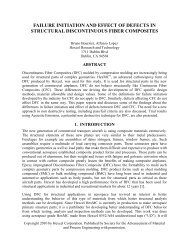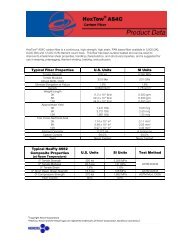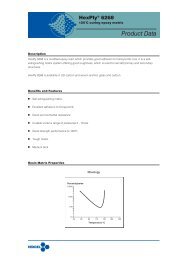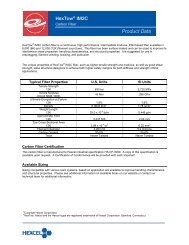Redux® Bonding Technology Brochure - Hexcel.com
Redux® Bonding Technology Brochure - Hexcel.com
Redux® Bonding Technology Brochure - Hexcel.com
Create successful ePaper yourself
Turn your PDF publications into a flip-book with our unique Google optimized e-Paper software.
Rev. July 2003<br />
Publication No. RGU 034c<br />
® <strong>Hexcel</strong> Registered Trademark<br />
© <strong>Hexcel</strong> Corporation<br />
REDUX BONDING TECHNOLOGY<br />
Almost everything that is made by industry has <strong>com</strong>ponent<br />
pieces which have to be joined together.<br />
One of the most efficient methods of joining these<br />
<strong>com</strong>ponents is adhesive bonding.<br />
This technique is capable of replacing or supplementing<br />
traditional joining methods and has its own special<br />
advantages.<br />
This manual explains the technology of bonding in a step-<br />
by-step guide.<br />
We have been developing and using adhesives for over 60<br />
years. The Redux ® trademark has achieved worldwide acclaim<br />
for aerospace and industrial bonding.<br />
1
REDUX BONDING TECHNOLOGY<br />
Contents<br />
Page<br />
Introduction 3<br />
Designing for <strong>Bonding</strong> 4<br />
Adhesive Selection 6<br />
Surface Preparation 7<br />
Adhesive Application 14<br />
Assembly of the Components 15<br />
Adhesive Curing 16<br />
Quality Control 16<br />
Safety 17<br />
Appendices: 1. Optimum Joint Design 18<br />
2. Fault Finding Hints 20<br />
3. Test Methods 21<br />
2
INTRODUCTION<br />
Why Bond?<br />
Adhesive bonding is a reliable, proven and widely established<br />
technique for joining metals, plastics, <strong>com</strong>posites and many<br />
other substrates.<br />
Metal bonding techniques were widely adopted and developed<br />
during and after World War 2 by the aircraft industry, from<br />
where they have subsequently spread to other sectors. Today,<br />
designers and engineers can choose between adhesive<br />
bonding, bolting, riveting, welding or soldering. In many cases<br />
the more cost-effective method will be bonding.<br />
Joints designed and bonded as re<strong>com</strong>mended by <strong>Hexcel</strong><br />
have several advantages over those made by traditional<br />
methods:<br />
! <strong>Bonding</strong> eliminates the need for holes and avoids subjecting<br />
the joint to welding temperatures that weaken metals. The<br />
cured adhesive, unlike rivets or bolts, ensures even distribution<br />
of stresses which leads to improved fatigue performances.<br />
mechanical joint bonded joint<br />
The riveted joint is highly stressed in the vicinity of the rivets (as<br />
shown by the arrows in the above diagram) and failure tends to<br />
initiate in these areas of peak stress. A similar distribution of<br />
stress occurs with spot welds and bolts.<br />
The bonded joint, however, is uniformly stressed. A continuous<br />
welded joint is likewise uniformly stressed but the metal in the<br />
heated zone will have undergone a change in performance.<br />
! <strong>Bonding</strong> saves weight.<br />
! On large area joints, bonded assemblies are generally less<br />
costly than their mechanical joint counterparts; simpler design,<br />
easier assembly and simpler tooling.<br />
! Bonded joints can allow for the assembly of dissimilar<br />
materials.<br />
! Bonded joints are electrically insulating and prevent<br />
electrolytic corrosion of conductor metals.<br />
! <strong>Bonding</strong> joints enables the design of smooth external<br />
surfaces, and integrally sealed joints with minimum sensitivity to<br />
crack propagation.<br />
! Bonded joints impart a stiffening effect <strong>com</strong>pared with<br />
riveting or spot welding.<br />
The diagram below shows how a joint may be designed to take<br />
advantage of the stiffening effect of bonding.<br />
Adhesives form a continuous bond between the joint surfaces.<br />
Rivets and spot welds pin the surfaces together only at<br />
localised points.<br />
Bonded structures are consequently much stiffer and loading<br />
may be increased (by up to 30-100%) before buckling occurs.<br />
Adhesives in Film Form<br />
mechanical joint<br />
bonded joint<br />
Redux adhesives are ready-to-use in the form of flexible films<br />
and require only a short period of heat and pressure to form<br />
very strong bonds.<br />
The film form ensures an optimum and controlled weight of<br />
adhesive containing exact proportions of resin and hardener.<br />
Film adhesives therefore require no mixing of <strong>com</strong>ponents; and<br />
are clean, safe and easy to work with. In addition, they are<br />
supplied with protective release paper and/or polythene sheet<br />
on either side.<br />
During the heating cycle the film liquefies and flows enough to<br />
wet the adherend surfaces, displaces any entrapped air (hence<br />
the need for pressure), and then cures to an infusible solid.<br />
Film adhesives are particularly useful for bonding large areas<br />
and especially useful in the fabrication of sandwich panels,<br />
particularly those incorporating honey<strong>com</strong>b core material.<br />
3
REDUX BONDING TECHNOLOGY<br />
DESIGNING FOR BONDING<br />
Designing a bonded joint<br />
<strong>Bonding</strong> with Redux film adhesives requires pretreatment of the<br />
substrates and a heating cycle. Consideration must therefore<br />
be given to whether the materials can withstand these<br />
processes.<br />
Bonded joints may be subjected to a range of stresses<br />
including tensile, <strong>com</strong>pressive, shear or peel and often a<br />
<strong>com</strong>bination of these.<br />
*Mean breaking stress is the breaking load per unit width divided by<br />
length of overlap. MPa is the unit of stress in which mean breaking<br />
stresses, or shear strengths, are quoted. See Units (page 18).<br />
Adhesives perform best in shear, <strong>com</strong>pression and tension.<br />
They behave relatively poorly under peel and cleavage loading.<br />
A bonded joint therefore needs to be designed so that the<br />
loading stresses will be directed along the lines of the<br />
adhesive’s greatest strengths.<br />
To indicate the performance of Redux adhesives, <strong>Hexcel</strong><br />
supplies a range of data sheets which demonstrate how a<br />
particular adhesive performs under a range of standard tests<br />
such as shear and peel strengths. Details of joint testing are<br />
explained in Appendix 3.<br />
For example, the standard test method for shear uses a<br />
simple lap joint made from metal sheet, usually an aluminium<br />
alloy, 1.63 mm thick with 12.5 mm overlap. The mean<br />
breaking stress* at room temperature<br />
(23 ! 2"C) will be in the range 15 to 50 MPa, depending on the<br />
adhesive. At the top end of this breaking stress range, joints<br />
made from aluminium alloy sheet of up to 1.5 mm thickness<br />
will yield or break in the metal.<br />
4
Typical joint types<br />
The basic types of bonded joints are shown diagrammatically.<br />
In practical structures two or more basic types may be used in<br />
<strong>com</strong>bination - and the relative dimensions of the joints may<br />
vary from those shown in the diagrams. In most cases the<br />
stress distribution throughout the joint can be improved by<br />
leaving intact the small amount of resin squeeze-out (fillet) and<br />
tapering the overlap to remove the sharp, right-angle ends.<br />
For optimum efficiency the amount of overlap can be calculated - See Appendix 1.<br />
Large sheets of thin gauge material (metal or plastics) may be<br />
stabilised by bonded stiffeners made of the same material in<br />
similar gauge. Figure 1 shows a ‘top hat’ stiffener.<br />
Towards the edge of the sheet, the stiffener may be cut away<br />
(as shown) in order to reduce stress concentrations. The effect<br />
is similar to that of the scarf joint shown above.<br />
Multi-layer structures may be built up by adhesive bonding and<br />
may also be bonded to other parts. In Figure 2 a multi-layer<br />
fibre-reinforced plastics laminate is joined to its neighbour by a<br />
multi-stepped lap joint. In Figure 3 an edge member is bonded<br />
into a sandwich panel. On loading, the stresses will be<br />
transferred into the panel. The honey<strong>com</strong>b core is itself<br />
assembled and bonded to the facing sheets with adhesives.<br />
Fig. 2 Fig. 3<br />
Fig. 1<br />
5
REDUX BONDING TECHNOLOGY<br />
ADHESIVE SELECTION<br />
The <strong>com</strong>prehensive range of Redux film adhesives is suitable<br />
for a diversity of applications. The first stage of design for<br />
bonding is the selection of the most suitable adhesive. <strong>Hexcel</strong><br />
publishes a selector guide with a summary of the main<br />
properties of the standard Redux adhesive range.<br />
Generic type<br />
Redux film adhesives are supplied in three main generic types:<br />
1. vinyl-phenolic - giving the best hostile environment<br />
resistance properties with temperature resistance up to 70"C.<br />
2. epoxy - giving higher strengths, toughness and<br />
temperature resistance up to 200"C.<br />
3. bismaleimide - giving even higher temperature resistance<br />
to above 220"C.<br />
Maximum service temperature<br />
The temperature at which adequate strength is maintained<br />
varies according to adhesive type and can range from 70"C to<br />
220"C. Most will retain their integrity down to -55"C.<br />
The ultra-high temperature resistant adhesives usually have<br />
reduced toughness and peel strength.<br />
Cure temperature<br />
Film adhesives generally fall into ca. 120"C curing or ca. 180"C<br />
curing categories. Choice depends on equipment availability,<br />
energy economy, or service temperature requirements (usually<br />
the higher the operating temperature the higher the cure<br />
temperature).<br />
Bondline thickness control<br />
During heating under pressure the adhesive will tend to<br />
squeeze out from a joint. Some film adhesives contain either a<br />
lightweight fabric ‘carrier’ or microspheres which ensure an<br />
optimum minimum bondline thickness automatically. This is<br />
useful for bonding small areas to prevent excessive squeezeout.<br />
Strength values often are slightly reduced by the presence<br />
of carriers and they prevent the use of the reticulation<br />
technique on to honey<strong>com</strong>b core (see page 14).<br />
Weight<br />
For good overall properties and bonding to honey<strong>com</strong>b core,<br />
areal weights of film adhesives in the range 150-400 g/m 2<br />
should be used. Where weight is critical lightweight film (60-<br />
150 g/m 2 ) can be adequate when close tolerance joints are<br />
achievable.<br />
Type approval<br />
Certain applications may require an adhesive to meet<br />
specification values for selected strength properties. Redux<br />
films are qualified to a wide range of international and specific<br />
aerospace specifications. Further details are available on<br />
request.<br />
Compatibility<br />
For co-curing with prepregs (fibre reinforced matrix<br />
<strong>com</strong>posites) to form a bonded sandwich structure, or as a<br />
‘surface finishing’ film for prepreg, both chemical and cure<br />
cycle <strong>com</strong>patibility are essential. Compatibility with surface<br />
pretreatment protection primers and honey<strong>com</strong>b core jointing<br />
foams is also necessary.<br />
6
SURFACE PREPARATION<br />
Introduction<br />
Whenever structural <strong>com</strong>ponents are to be produced using<br />
adhesive bonding, the condition of the adherend surfaces<br />
must be considered. They are likely to be contaminated with<br />
materials which could affect adversely the performance of the<br />
resultant joint.<br />
Surface pretreatment will, therefore, normally be necessary if<br />
optimum performance is to be achieved. It will be vital if good<br />
environmental or thermal durability is required.<br />
Dependent on the substrate, surfaces are prepared by one of<br />
the following pretreatment procedures (for many substrates,<br />
this list is in increasing order of effectiveness):<br />
1) Degrease only.<br />
2) Degrease, abrade and remove loose particles.<br />
3) Degrease and chemically pretreat.<br />
Care must be taken to avoid contaminating the surfaces<br />
during or after pretreatment. Contamination may be caused<br />
by finger marking - or by cloths which are not perfectly clean -<br />
or by contaminated abrasives - or by sub-standard<br />
degreasing or chemical solutions.<br />
Contamination may also be caused by other work processes<br />
taking place in the bonding area. Particularly to be excluded<br />
are oil vapours from machinery, spraying operations (paint,<br />
mould release agents, etc.) and procedures involving<br />
powdered materials.<br />
Whatever the pretreatment procedure used, it is good practice<br />
to bond the substrates as soon as possible after <strong>com</strong>pletion,<br />
i.e. when the surfaces are most ‘active’ (surface properties are<br />
at their best) {1}.<br />
Degreasing Methods<br />
For nearly all bonding applications, the removal of all traces of<br />
oil and grease from the adherend is essential.<br />
Remove all traces of oil and grease as follows:<br />
(not re<strong>com</strong>mended for some plastic adherends as they might<br />
well be attacked by the degreasing solvent. Refer to <strong>Hexcel</strong><br />
for detailed advice.)<br />
(a) Suspend the part in the vapour of a suitable alkaline<br />
degreasing agent{2} in a vapour degreasing unit. The unit<br />
may contain a <strong>com</strong>partment to enable initial washing in the<br />
liquid solvent.<br />
For metallic substrates, and particularly aluminium, this<br />
vapour degreasing process can be augmented by immersion<br />
in a warm, aqueous solution of a suitable alkaline degreasing<br />
agent (for example, a 10-minute immersion of aluminium<br />
sheet in an aqueous solution of Turco T 5215 ® at 70"C)<br />
followed by a spray-rinse in clean water. If further chemical<br />
pretreatment is to take place then, the substrate will not, of<br />
necessity, have to be dried. If no further treatment is<br />
contemplated then the adherend should be dried thoroughly -<br />
preferably in a stream of warm air (ca. 40"C), e.g. in an aircirculating<br />
oven or from a domestic forced-air heater.<br />
or Where a vapour degreasing unit is not available:<br />
(b) Immerse successively in two tanks each containing the<br />
same solvent {2}. The first tank acts as a wash, the second<br />
as a rinse. (Currently, either 1,1,1-trichloroethane or<br />
trichlorotrifluoroethane are used, but in view of the pending<br />
legislation {2} the use of acetone, in spite of the associated<br />
flammability problems, should be considered). When the<br />
solvent in the wash tank be<strong>com</strong>es heavily contaminated, the<br />
tank should be emptied, cleaned out and refilled with fresh<br />
solvent {3}. This tank is then used for the rinse and the former<br />
rinse tank for the wash.<br />
Environmentally more acceptable alternatives to these<br />
solvents are under development and include materials based<br />
on alcohols, terpenes and water. <strong>Hexcel</strong> will, themselves, be<br />
changing to any of these novel materials as soon as their<br />
efficacy has been proven, and strongly re<strong>com</strong>mend that other<br />
users make a similar change at that time.<br />
or<br />
(c) If safety considerations permit, brush or wipe the<br />
adherend surfaces with a clean brush or cloth soaked in clean<br />
acetone. For fine work, washing down with solvent applied by<br />
aerosol spray may be a more suitable alternative; this<br />
technique also ensures that the solvent used is clean. Allow to<br />
stand for about 5 minutes to permit <strong>com</strong>plete evaporation<br />
from the joint surfaces. Good local extraction will have to be<br />
employed (at the same time ensuring <strong>com</strong>pliance with the<br />
requirements of any local or national environmental<br />
regulations).<br />
or<br />
(d) Scrub the adherends in a solution of liquid detergent.<br />
Wash with clean hot water and allow to dry thoroughly -<br />
preferably in a stream of warm (ca. 40"C) air, e.g. in an aircirculating<br />
oven or from a domestic forced-air heater.<br />
7
REDUX BONDING TECHNOLOGY<br />
SURFACE PREPARATION (continued)<br />
Test for a clean bonding surface<br />
The water-break test is a simple method to determine whether<br />
the surface to be bonded is clean. It is best suited to metals. If<br />
a few drops of distilled water applied to the adherend wet and<br />
spread - or if, on drawing the substrate from out of an<br />
aqueous medium, the water film does not break up into<br />
droplets - then the surface may be assumed to be free of<br />
contamination. Uniform wetting of the surface by water<br />
indicates that it will probably be likewise wetted by the<br />
adhesive.<br />
It must be borne in mind that certain plastics, even when<br />
clean, may not be wetted by water but will be wetted by the<br />
adhesive. Furthermore, satisfactory wetting gives no<br />
information as to the potential bond strength. At best, it is a<br />
necessary - but not sufficient - requirement for the<br />
achievement of high bond strengths.<br />
Abrading Methods<br />
For many substrates (but not all - see the section on<br />
aluminium, for instance), light abrasion of the surfaces to be<br />
bonded can allow the adhesive to key better than when a<br />
highly polished adherend is used. Highly active surfaces,<br />
such as those produced immediately following abrasion, tend<br />
to have a better affinity for the adhesive.<br />
As well as producing an active surface, abrasion<br />
pretreatments are generally intended to remove surface<br />
deposits, such as oxide tarnish, rust or mill scale, on metallic<br />
substrates, particularly those which are ferrous-based, or to<br />
remove the surface layer of ‘plastics’ to ensure elimination of<br />
all traces of release agent etc. In this latter case, care must be<br />
taken to avoid <strong>com</strong>pacting the release agent into the surface<br />
which is being pretreated, instead of removing it.<br />
In all cases, the use of air- or water-borne grit-blasting is,<br />
generally, the best method of achieving these ends; provided<br />
every effort is made to use dry, clean <strong>com</strong>pressed air and to<br />
prevent contaminated abrading media from <strong>com</strong>ing into<br />
contact with the surface to be pretreated.<br />
The choice of grit type (fused alumina, chill-cast iron shot or<br />
silicon carbide) will be dependant on the substrate to be<br />
abraded - e.g. alumina grit would not be used on mild steel<br />
<strong>com</strong>ponents because of the possibility of galvanic corrosion;<br />
chill-cast iron shot would be used. Selection of grit size will<br />
also depend on several factors: again, the metal to be<br />
pretreated, the type of equipment being used, the pressure<br />
and angle of blast impact and the blasting time. Grits in the<br />
range of 125 to 315 #m {4} are suitable, but the optimum size<br />
for the work in hand can only be determined by trials. In<br />
general, for soft materials the optimum grit size will be<br />
towards the finer (i.e. 125 #m) end of the range.<br />
Note: Water-borne grit-blasting of ferrous materials<br />
necessitates thorough drying of the adherends immediately<br />
after pretreatment; alternatively, a rust inhibitor must be<br />
added to the water.<br />
When grit-blasting plastic materials pretreatment times should<br />
be kept to a minimum to avoid surface melting.<br />
If grit-blasting equipment is not available or the substrate<br />
(either metallic or plastic) is too delicate to withstand such<br />
pretreatment, then clean the surfaces to be bonded with a<br />
suitable abrasive cloth (e.g. Scotchbrite ® ), a hand- or poweroperated<br />
wire brush or water-proof abrasive paper (the<br />
average particle size abrasive bonded to the paper should,<br />
again, be in the range of 125 to 315#m).<br />
When using such techniques, operating under wet conditions<br />
(i.e. in the presence of water) can assist in the removal of<br />
contaminant and keeps dust generation to a minimum. If wet<br />
techniques are used, then the substrate should be thoroughly<br />
dried immediately after pretreatment.<br />
Any abrasion pretreatment carried out must be followed by a<br />
further operation to ensure <strong>com</strong>plete removal of loose and<br />
loosely-bound particles (from both the abrasion medium and<br />
substrate). For example:<br />
(a) Lightly brush with a clean soft brush, or - preferably<br />
(b) Blow clean with an uncontaminated, dry (filtered)<br />
<strong>com</strong>pressed-air blast.<br />
The substrate should finally be degreased.<br />
Chemical Pretreatments<br />
The surface pretreatments described above, i.e. degreasing<br />
alone or degreasing followed by abrasion and removal of the<br />
loose particles is sufficient to ensure, for several substrate<br />
types, that good, strong bonds will be formed with the<br />
adhesive being used. However, for many adherends, to<br />
obtain maximum strength, reproducibility and long-term<br />
durability, a chemical pretreatment will be required to modify<br />
the surface, or surface chemistry, in such a way as to make it<br />
suitable for structural adhesive bonding.<br />
For metallic adherends most of these pretreatments either<br />
involve acid etching or an acid etch followed by an acidic<br />
anodizing process. [SEE NOTE ON PAGE 13 FOR DISPOSAL<br />
OF WASTE]<br />
Surface modification of plastic materials is, nowadays,<br />
frequently carried out by exposing the surface to be bonded<br />
to a controlled flame, plasma or corona discharge.<br />
8
Specific Pretreatments For Specific Adherends<br />
The following pretreatments are relatively well established but<br />
on certain occasions a different procedure (not given here)<br />
may prove more effective. (The BSI revision of<br />
CP 3012 : 1972 is a useful source of information)<br />
Metallic Substrates<br />
Individual alloys within each metal group (and the particular<br />
surface structures caused by different heat treatments) may<br />
respond differently to a given pretreatment. The effectiveness<br />
of one pretreatment over another can be shown only by<br />
<strong>com</strong>parative trials - using both the type of metal and the<br />
adhesive specified for the work.<br />
In virtually all cases where chemical pretreatment has been<br />
used, the water-break test can be used to confirm the<br />
effectiveness of the process.<br />
Painted Metals<br />
Any paint, which has relatively low adhesion to metal, should<br />
first be stripped off and the metal surface so exposed should<br />
then be subjected to a suitable pretreatment.<br />
Aluminium and Aluminium Alloys<br />
Aluminium Honey<strong>com</strong>b<br />
Unless there are obvious signs of contamination, aluminium<br />
honey<strong>com</strong>b does not require pretreatment prior to bonding.<br />
Should, however, any oil or grease contamination be evident,<br />
then the affected slice should be immersed in the vapour of a<br />
suitable hydrocarbon solvent {2} in a vapour degreasing unit.<br />
After immersion, always allow sufficient time for the<br />
honey<strong>com</strong>b core to drain dry. This is particularly important as<br />
liquid solvent held in the corners of the honey<strong>com</strong>b cell can<br />
be very difficult to detect and must be removed before<br />
bonding.<br />
Aluminium Sheet<br />
Due to the relatively high ductility of aluminium, it is not<br />
re<strong>com</strong>mended that such adherends are pretreated by any of<br />
the abrasion methods. Far better is a vapour and/or alkaline<br />
degrease followed by an acid etch (pickling) {5} or by a<br />
suitable anodizing process {6}. A controlled film of active,<br />
aluminium oxide, highly suitable for structural bonding, is<br />
grown on the surface of the aluminium; its thickness being<br />
dependent on the chemical process and the alloy used.<br />
<strong>Bonding</strong> should then take place within 2 - 8 hours of<br />
pretreatment {1}.<br />
Chromic/Sulphuric Acid Pickling [CSA]<br />
A suitable pickling solution of sodium dichromate in sulphuric<br />
acid, can be made up as follows:<br />
Water 1.500 litres<br />
Concentrated Sulphuric Acid [Sg: 1.83] 0.750 litres<br />
Sodium Dichromate [Na 2 Cr 2 O 7 .2H 2 O] 0.375 kg<br />
(or Chromium Trioxide [CrO 3 ] 0.250 kg)<br />
Water make up to 5.0 litres<br />
Warning: Handle concentrated sulphuric acid with care using<br />
all the re<strong>com</strong>mended personal protection equipment;<br />
always add to water.<br />
Chromium trioxide is a powerful oxidising agent and is highly<br />
toxic; particular care is essential when handling this<br />
chemical. It, or the chromate, should be dissolved in diluted<br />
sulphuric acid.<br />
Regulate the pickling bath at 60 - 65"C and then immerse the<br />
substrate to be pretreated, for 30 minutes. At the end of this<br />
time remove and immerse in a tank of water at ambient<br />
temperature. Follow this with a spray-rinse with cold water.<br />
The pretreated <strong>com</strong>ponents can then be air-dried, preferably<br />
in an air-circulating oven whose air temperature is no greater<br />
than 45"C.<br />
<strong>Bonding</strong> should take place within 8 hours {1}.<br />
Chromic Acid Anodizing [CAA]<br />
A thicker, more “robust” oxide film can be grown if chromic<br />
acid anodising is used. Here, the pickled aluminium<br />
substrates (under certain circumstances it may be sufficient to<br />
use only an alkaline degrease before anodizing) are clamped<br />
to the anode of a standard anodizing bath and are immersed<br />
in a solution of chromic acid, at 40"C, of the following<br />
<strong>com</strong>position:<br />
Chromium Trioxide [CrO 3 ] 0.500 kg<br />
Water 10.0 litres<br />
The anodizing voltage is raised, over a 10-minute period, to<br />
40 V, held for 20 minutes, raised over a 5-minute period, to 50<br />
V and held for 5 minutes. At the end of this cycle the<br />
<strong>com</strong>ponents are removed and immersed in a tank of water at<br />
ambient temperature. This is followed by a spray-rinse with<br />
cold water. The anodized <strong>com</strong>ponents can then be air-dried,<br />
preferably in an air-circulating oven whose air temperature is<br />
no greater than 45"C.<br />
<strong>Bonding</strong> of the unsealed <strong>com</strong>ponents should take place<br />
within 4 - 6 hours {1}.<br />
9
REDUX BONDING TECHNOLOGY<br />
SURFACE PREPARATION (continued)<br />
Phosphoric Acid Anodizing [PAA]<br />
To obtain a more open oxide film but thinner than that<br />
produced by chromic acid anodizing, aluminium adherends<br />
can be anodized in phosphoric acid; the anodic oxide<br />
contains ‘bound’ phosphate which will impart some degree of<br />
durability to the final adhesive joint.<br />
Here, the pickled aluminium substrates (under certain<br />
circumstances it may be sufficient to use only an alkaline<br />
degrease prior to anodizing) are clamped to the anode of a<br />
standard anodizing bath and are immersed in a solution of<br />
phosphoric acid, at 25"C, of the following <strong>com</strong>position:<br />
“Syrupy” Orthophosphoric Acid [Sg: 1.65] 1.0 litres<br />
Water 16.6 litres<br />
(Concentration of phosphoric acid is 75 g/l)<br />
The anodizing voltage is raised to 10 - 15V (preferably 15V)<br />
and is held for 20 - 25 minutes. At the end of this time the<br />
adherends are removed and immersed in a bath of water at<br />
ambient temperature. This is followed by a spray-rinse with<br />
cold water. The anodized adherends can then be air-dried,<br />
preferably in an air-circulating oven where the air temperature<br />
is no greater than 45"C.<br />
<strong>Bonding</strong> of the unsealed <strong>com</strong>ponents should take place<br />
within 2 - 4 hours {1}.<br />
Sulphuric acid anodizing techniques can be used to pretreat<br />
aluminium and its alloys but significantly lower adhesive<br />
strengths and durability will result when <strong>com</strong>pared with CSA,<br />
CAA or PAA pretreatments. This situation can be relieved by<br />
dipping the anodised <strong>com</strong>ponents in a solution of phosphoric<br />
acid to dissolve away some of the anodic oxide layer to reveal<br />
a more open structure more amenable to adhesive bonding.<br />
Pre-Anodized Aluminium<br />
Decorative (sealed), anodized aluminium or aluminium alloys<br />
are, as such, not suitable for adhesive bonding; these types<br />
of substrate require stripping prior to use. Stripping is<br />
sometimes ac<strong>com</strong>plished by abrasive blasting but this sort of<br />
treatment is not really to be re<strong>com</strong>mended. The anodic oxide<br />
film is best removed by immersion in the chromic/sulphuric<br />
acid solution given above.<br />
Once the sealed oxide layer has been removed, one of the<br />
conventional pretreatments for aluminium can be used.<br />
Copper and Nickel<br />
Degrease as above and then either abrade or etch at 23! 2"C<br />
in the relevant solution of concentrated nitric acid:<br />
Material Copper and Nickel and<br />
Copper Alloys Nickel Alloys<br />
Etch Solution Concentrated nitric Undiluted<br />
acid [Sg: 1.42] and concentrated<br />
water in the ratio of nitric acid<br />
1 : 3 [by volume]. [Sg: 1.42]<br />
Immersion Time 30 seconds 5 seconds<br />
Warning: Concentrated nitric acid is highly corrosive and a<br />
powerful oxidising agent; particular care is needed when<br />
handling.<br />
After treatment, spray-rinse with clean, cold water followed by<br />
clean, hot water. Dry in a stream of hot air.<br />
Optimum bond strength can then be obtained if the<br />
pretreated surfaces are primed with a solution of Araldite ®<br />
DZ 81; this primer, however, requires drying, followed by<br />
curing at 175"C for 1 hour.<br />
Cupronickel Alloys<br />
Trials are re<strong>com</strong>mended to establish the optimum solution<br />
concentration and immersion time (as in Copper and Nickel<br />
above) for each particular alloy.<br />
Steel - Mild<br />
Degrease as above and then, wherever possible, abrade<br />
using a grit-blaster loaded with chill-cast iron shot.<br />
A chemical etching pretreatment can be used instead but all<br />
evidence appears to indicate that this is not the optimum<br />
pretreatment. To carry out such a treatment, immerse the<br />
adherends for 10 minutes at 60"C, in a solution of the<br />
following <strong>com</strong>position:<br />
Industrial Methylated Spirits 2.0 litres<br />
Orthophosphoric Acid [Sg: ca. 1.7] 1.0 litre<br />
At the end of this time, remove the <strong>com</strong>ponents from the<br />
solution and then, under clean, cold, running water, brush off<br />
any black deposit with a clean, stiff-bristle, nylon brush.<br />
Absorb residual water by wiping with a clean cloth soaked<br />
with clean industrial methylated spirits or iso-propanol. Heat,<br />
in an air-circulating oven, for 1 hour at 120"C.<br />
Several proprietary phosphating systems are also available for<br />
the pretreatment of mild steel. Again, the evidence appears to<br />
indicate that grit-blasting is the optimum form of treatment for<br />
adhesive bonding.<br />
10
Steel - Stainless<br />
Note: It is strongly re<strong>com</strong>mended that, before attempting to<br />
bond stainless steel <strong>com</strong>ponents, <strong>Hexcel</strong> is consulted. This is<br />
to establish the trials which should take place to determine<br />
the optimum method and conditions needed to obtain the<br />
best bond strengths with the particular stainless steel being<br />
used. Such trials will also take into account end usage;<br />
particularly the durability requirements.<br />
Stainless steel (i.e. corrosion-resisting steel having a<br />
chromium content !9% m/m) is well known to be difficult to<br />
bond, especially where long-term environmental<br />
resistance is concerned.<br />
The correct pretreatment, therefore, is vital and, amongst<br />
other considerations, will be dependant on the minimum<br />
specified tensile strength of the substrate as well as the<br />
projected end use of the bonded <strong>com</strong>ponent.<br />
Several pretreatments are re<strong>com</strong>mended by the British<br />
Standards Institute 1992 revision of CP 3012: 1972. In<br />
essence, these methods cover solvent and/or alkaline<br />
degreasing followed by surface abrasion or by the use of a<br />
chemical etchant. Grit blasting, using chill-cast iron shot,<br />
glass or alumina, is the ideal abrasion technique and<br />
etchants based on sulphuric, hydrochloric of phosphoric acid<br />
are re<strong>com</strong>mended; etching conditions are 5 - 30 minutes at<br />
room temperatures of up to 65"C.<br />
In many cases, the chemically pretreated substrates will<br />
require desmutting after etching and washing. This can be<br />
ac<strong>com</strong>plished by immersion in the standard CSA pickling<br />
solution (see above) for 5 - 20 minutes at 60 - 65"C. Once<br />
such a bath has been used for desmutting stainless steel<br />
the chromic/sulphuric acid cannot be used again for the<br />
pretreatment of aluminium.<br />
Work by <strong>Hexcel</strong> has shown that adequate bond strengths<br />
can be obtained on fresh specimens following grit-blast,<br />
sulphuric/oxalic acid etching or hydrochloric acid/Formalin/<br />
hydrogen peroxide etching. The latter has been shown to<br />
give better bath stability.<br />
Titanium and Titanium Alloys<br />
Degrease as above and then either abrade, ideally by gritblasting,<br />
or etch and then anodize in chromic acid as follows:<br />
Pre-etch, at ambient temperatures, for 10 - 20 minutes in a<br />
solution of:<br />
Concentrated Nitric Acid [Sg: 1.42] 4.5 litres<br />
Hydrofluoric Acid [Sg: 1.17] 0.450 litres<br />
Water 10.0 litres<br />
Warning: Both acids are highly corrosive and toxic.<br />
Particular care is essential when handling these<br />
chemicals; use all the re<strong>com</strong>mended personal protection<br />
equipment. Do not use glass equipment with hydrofluoric<br />
acid; polythene or polypropylene containers are suitable.<br />
Remove from the bath and then, under clean, cold, running<br />
water, brush off any black deposit with a clean, stiff-bristle,<br />
nylon brush.<br />
Clamp the etched substrates to the anode of a standard<br />
anodizing bath (anode : cathode ratio of ca. 3 : 1) and<br />
immerse, at 40"C, in chromic acid of the following<br />
<strong>com</strong>position:<br />
Chromium Trioxide [CrO 3 ] 0.700 kg<br />
Water 10.0 litres<br />
Warning: Chromium trioxide is a powerful oxidising agent and<br />
is highly toxic; particular care is essential when handling<br />
this chemical.<br />
Raise the voltage to 20 V over a 5-minute period and hold<br />
(dependent on alloy type) for 5 - 30 minutes; the titanium<br />
should have developed a distinctive blue colouration.<br />
Remove from the anodizing bath, spray-rinse with cold water<br />
and air dry, preferably in an air-circulating oven whose air<br />
temperature does not exceed 45"C.<br />
11
REDUX BONDING TECHNOLOGY<br />
SURFACE PREPARATION (continued)<br />
Plastic Substrates<br />
Tests or technical advice (from <strong>Hexcel</strong> or the substrate<br />
supplier) may be needed as to the degreasing solvent to be<br />
used for thermosetting or, more particularly, thermoplastic<br />
polymeric substrates (certain plastics are attacked by certain<br />
halocarbon or ketonic solvents).<br />
Thermosetting Plastics<br />
Castings, mouldings, laminates, etc., manufactured from:<br />
Amino, diallyl phthalate, epoxy, phenolic, polyimide or<br />
unsaturated polyester plastics.<br />
Degrease and abrade as above.<br />
Thermosetting Fibre-Reinforced Laminates<br />
With wet lay-up, RTM or RIM <strong>com</strong>ponents or laminates<br />
prepared from prepregs, it may be possible to design the<br />
laminating process so that one peel ply of fabric is placed on<br />
the surface to be bonded; this peel ply be<strong>com</strong>es part of the<br />
laminate on curing.<br />
Just prior to bonding, the peel ply is peeled off, removing<br />
with it some of the excess cured matrix material, which<br />
exposes a fresh, clean surface for bonding.<br />
To obtain optimum bond strengths, the laminates should, if<br />
possible, be dried before bonding to remove any moisture<br />
absorbed from the atmosphere. This should be carried out,<br />
after removal of the peel ply (if present), in an air-circulating<br />
oven at a temperature at which no thermal damage will be<br />
imparted to the laminate {7}.<br />
The peel ply technique gives a very reproducible surface on<br />
which to bond. However, a resin-rich layer remains on the<br />
laminate surface which can lead to a reduction in the actual<br />
level of bond strengths achievable.<br />
This latter situation can be addressed by the careful use of<br />
hand-abrasion or grit-blasting pretreatments. Although this<br />
can lead to an improvement in bond strengths, the<br />
techniques are highly operator-dependent. This will invariably<br />
cause some fibre damage and occasionally (particularly<br />
when using hand-abrasion) an uneven removal of <strong>com</strong>posite<br />
surface.<br />
Thermoplastic Plastics<br />
Thermoplastic polymeric substrates vary in the ease with<br />
which they can be bonded. Significant factors are the type<br />
and grade of polymer, the <strong>com</strong>pounding ingredients and the<br />
moulding conditions. Tests may be needed to determine<br />
bond strength under a given set of conditions.<br />
Many of the surface pretreatments for such plastics as:<br />
ABS, acetals, polyamides (nylons), polycarbonates,<br />
polyesters, poly(meth)acrylates, polyolefines,<br />
polytetrafluoroethylene, polyethersulphones, polyurethanes,<br />
etc. have been, traditionally, chemical in nature. Currently,<br />
novel techniques such as flame, corona and plasma<br />
treatments are producing pretreated surfaces capable of<br />
supporting bonds with excellent strength properties.<br />
For further details, refer to <strong>Hexcel</strong>.<br />
Thermoplastic Fibre-Reinforced Laminates<br />
Currently this type of substrate is, essentially, limited to those<br />
produced using polyetheretherketone or polyethersulphone<br />
matrices on carbon fibre.<br />
Pretreatment should <strong>com</strong>prise some form of degreasing<br />
followed either by a controlled hand-abrasion or grit-blasting<br />
or by a corona discharge technique.<br />
For further details, refer to <strong>Hexcel</strong> or check with the plastic<br />
supplier, who can generally re<strong>com</strong>mend a treatment for<br />
bonding.<br />
Plastic Foams<br />
Foams made from phenolic resins, polyurethane, PVC, etc.,<br />
usually require no pretreatment. It suffices to ensure that the<br />
surfaces are clean, dry and dust-free (a vacuum cleaner is<br />
re<strong>com</strong>mended).<br />
12
Non-Metallic Honey<strong>com</strong>bs<br />
Honey<strong>com</strong>bs produced from such materials as aramid<br />
paper, require no pretreatment unless contaminated.<br />
However, higher bond strengths are obtained if the<br />
honey<strong>com</strong>b is dried for 1 hour at 120"C just before bonding.<br />
REFERENCES<br />
{1} If the scheduling of bonding operations on multi-part<br />
assemblies causes delay between pretreatment and<br />
bonding, optimum surface properties may be preserved by<br />
priming the areas to be bonded with a suitable adhesive<br />
primer, or pretreatment protection solution immediately after<br />
pretreatment.<br />
{2} The standard solvents are currently alkaline degreasing<br />
agents - such as Turco 4215 NCLT.<br />
WARNING: Safety precautions must be observed where<br />
solvents are in use.<br />
{3} The waste solvent should be disposed of in accordance<br />
with the manufacturer’s instructions and the local regulations.<br />
ENVIRONMENT<br />
{4} FEPA Standard 42-GB-1984: Bonded Abrasive Grain<br />
Size Standard (Fused Aluminium Oxide and Silicon Carbide).<br />
{5} The pickling procedure outlined in the text conforms to<br />
Method O of BSI Code of Practice CP 3012 (Method O of<br />
DEF Standard 03-2/1) as well as to the older specification<br />
DTD 915B. It is also approximately equivalent to the<br />
procedure developed by the Forest Products Laboratory,<br />
Wisconsin, USA, and which is known as the “FPL Etch”.<br />
{6} The two usual methods of anodising aluminium and its<br />
alloys for bonding are carried out in either chromic acid<br />
(essentially to DEF Standard 03-24/2) or phosphoric acid<br />
(essentially to the Boeing specification BAC 5555).<br />
{7} Thermoset laminates should be dried in accordance<br />
with prEN 2823.<br />
Note Also: For local suppliers of pretreatment materials and<br />
adhesive processing equipment, please refer to a suitable<br />
chemical and allied trades directory.<br />
ALL WASTE, EXHAUSTED OR CONTAMINATED CHEMICALS MUST BE DISPOSED OF IN ACCORDANCE WITH THE<br />
MANUFACTURER’S INSTRUCTIONS AND NATIONAL AND LOCAL REGULATIONS.<br />
THIS IS NORMAL, EVERYDAY PRACTICE WITHIN THE CHEMICALS INDUSTRY - HEXCEL WILL BE HAPPY TO ADVISE.<br />
13
REDUX BONDING TECHNOLOGY<br />
ADHESIVE APPLICATION<br />
All film adhesives have a ‘shelf life’ at room temperature,<br />
varying from a few weeks to several months, which can be<br />
extended by refrigeration.<br />
If the adhesive has been cold stored allow the whole package<br />
to warm thoroughly to room temperature ( ideally 24 hours)<br />
before opening. This will avoid condensation occurring and<br />
prevent problems with processing.<br />
The film is supplied with a release paper backing on one<br />
surface and a polythene interleave on the other. Both must be<br />
removed before curing.<br />
Two methods of adhesive application are <strong>com</strong>mon:<br />
1. Cut the film to size before removing the release paper<br />
backing. Then lay the adhesive film on to the pretreated<br />
surface to be bonded and peel off the polythene interleave.<br />
Finally apply the other substrate to the exposed adhesive<br />
surface.<br />
2. Unroll the film on to a cutting surface and remove the<br />
polythene interleave. Apply the pretreated surface of the<br />
<strong>com</strong>ponent to be bonded. Cut around the profile then remove<br />
the release paper backing. Apply to the other surface to be<br />
bonded.<br />
The films are essentially ‘dry’ but will tack readily to most<br />
prepared surfaces. The amount of tackiness is dependent on<br />
the film temperature and additional heat can be applied to<br />
increase tack if required.<br />
Reticulation<br />
When bonding honey<strong>com</strong>b panels having perforated skins,<br />
blocking of the perforations can be minimised by first<br />
reticulating the film adhesive on to the ends of the honey<strong>com</strong>b<br />
cell walls or the perforated skin.<br />
On a large production scale this can be ac<strong>com</strong>plished by first<br />
tacking the adhesive to the honey<strong>com</strong>b or perforated skin and<br />
then passing over jets of hot air.<br />
Surface finish<br />
Additional resin at the surface of prepreg <strong>com</strong>ponents can<br />
improve the finish by eliminating ‘pin holes’ especially in<br />
honey<strong>com</strong>b cored <strong>com</strong>ponents. Specially formulated film<br />
adhesives can be used for this purpose and are tacked into<br />
position against the tool or the prepreg and co-cured.<br />
14
ASSEMBLY OF THE COMPONENTS<br />
Assembly<br />
As the <strong>com</strong>ponent is heated to the cure temperature the<br />
adhesive will melt and flow. In order to produce a satisfactory<br />
bond the <strong>com</strong>ponents must be held together without<br />
movement until after the adhesive has be<strong>com</strong>e solid and<br />
cooled. This is ac<strong>com</strong>plished in a variety of ways depending<br />
on the type of adhesive, the type of <strong>com</strong>ponent to be bonded<br />
and the production rate required.<br />
! Hydraulic press with heated platens.<br />
Ideal for large flat <strong>com</strong>ponents including sandwich panels.<br />
Good production rates are possible with multi daylight<br />
presses. Heating is usually by electricity, steam or heated oil<br />
and with suitable equipment, automatic cure cycles can be<br />
programmed.<br />
Additional tooling will enable the flat press platens to be used<br />
for some curved or angled <strong>com</strong>ponents.<br />
! Tooling fixtures<br />
For <strong>com</strong>plicated <strong>com</strong>ponents with returns, purpose made<br />
tooling is required and curing ac<strong>com</strong>plished in an oven or an<br />
induction heated station, pressure being applied by sprung<br />
clamps.<br />
! Vacuum bag<br />
In the absence of a press, this is a way of applying holding<br />
pressure to flat or curved <strong>com</strong>ponents while oven curing.<br />
Bags may be purpose made to suit using a rubber<br />
diaphragm. Some reduction in strength may occur due to the<br />
sub-atmospheric pressure increasing the volume of the<br />
unavoidable, entrapped air in the adhesive joint.<br />
! Autoclave<br />
For very large or <strong>com</strong>plicated, curved <strong>com</strong>ponents requiring<br />
higher pressures, a large autoclave can be used and may<br />
cure several different <strong>com</strong>ponents at the same time. The<br />
capital cost is high and the bonding time relatively slow.<br />
! Riveting and weld-bonding<br />
For large, multi-<strong>com</strong>ponent structures it is fairly <strong>com</strong>mon<br />
practice to ‘fix’ the assembly prior to bonding by the judicious<br />
placing of either rivets or spot-welds through the bondline to<br />
give dimensional stability to the unbonded structure<br />
(Figure 4).<br />
Fig. 4 Combination joints<br />
(a) weld-bonding construction<br />
(b) toggle lap-joint made with both rivets and adhesive.<br />
15
Adhesive Temp ("C)<br />
REDUX BONDING TECHNOLOGY<br />
ADHESIVE CURING<br />
Adhesive curing<br />
The time and temperature required for curing the film<br />
adhesive is specified in the individual Data Sheet for the<br />
adhesive chosen. A typical cure cycle is shown.<br />
200<br />
160<br />
120<br />
80<br />
40<br />
0<br />
Heating<br />
5"C/min<br />
temperature<br />
pressure<br />
20 min 60 min<br />
20 min<br />
time<br />
Cooling<br />
It should be noted that the temperature required is that of the<br />
adhesive and not that of the oven or press. To determine the<br />
adhesive temperature a thermocouple is required to be<br />
placed in an appropriate position within the <strong>com</strong>ponent close<br />
to the adhesive.<br />
The ramp rate (i.e. the rate at which the bondline temperature<br />
is allowed to rise to the required cure temperature) is usually<br />
controlled at 1-5"C/minute; an uneven heating rate between<br />
parts of the <strong>com</strong>ponent can result in distortion due to<br />
‘bonded-in’ thermal stresses.<br />
QUALITY CONTROL<br />
Quality control can vary from simple strength tests on bonded<br />
joints to sophisticated non-destructive testing (NDT)<br />
techniques.<br />
For many applications test specimens, pretreated and cured<br />
alongside the <strong>com</strong>ponent, are sufficient. Standard test<br />
methods for lap shear strength, metal/metal peel strength and<br />
skin/core peel strength are used where appropriate and<br />
details are included in appendix 3.<br />
5<br />
4<br />
3<br />
2<br />
1<br />
0<br />
Pressure (bar)<br />
The rate should then be lowered or the heating cycle ‘dwelled’<br />
so that even heating occurs. The ‘dwell’ allows the<br />
temperature to stabilise across the <strong>com</strong>ponent and will be<br />
applied before reaching the vital point at which gelation<br />
occurs.<br />
After curing it is advisable to maintain pressure on the<br />
<strong>com</strong>ponents until cooled, although if no stresses are present it<br />
may not be necessary.<br />
Modified cure cycles are possible after suitable trials. For<br />
example, for high production rates of small <strong>com</strong>ponents, it is<br />
possible to use induction heating at a higher cure temperature<br />
for a shorter time, as in the diagram below.<br />
Adhesive Temp ("C)<br />
200<br />
160<br />
120<br />
80<br />
40<br />
0<br />
30<br />
sec<br />
60<br />
sec<br />
120<br />
sec<br />
temperature<br />
pressure<br />
5<br />
4<br />
3<br />
2<br />
1<br />
0<br />
Pressure (bar)<br />
16
SAFETY<br />
Handling Precautions<br />
Redux adhesives in film form are particularly free from<br />
handling hazards for the following reasons:<br />
! film is covered on both sides by protective release paper<br />
and/or polythene which are not removed until final <strong>com</strong>ponent<br />
assembly. It should be cut to shape before removing the<br />
protective coverings and virtually no handling of the film is<br />
necessary<br />
! The film is dependent on elevated temperature for wettingout<br />
the adherend surfaces<br />
! volatile-free at normal room temperature<br />
! splash-free, leak-free, spillage-free<br />
However, the usual precautions when handling synthetic<br />
resins should be observed, and, in <strong>com</strong>pliance with various<br />
national and international health and safety legislation, <strong>Hexcel</strong><br />
has prepared Safety Data Sheets for each product. They are<br />
available on request.<br />
Acids, caustic soda, etc.<br />
Concentrated acids, oxidising agents (e.g. chromium trioxide,<br />
dichromates) and caustic soda are highly corrosive chemicals.<br />
Spillages and splashes can cause severe damage to eyes<br />
and skin, and attack ordinary clothing. Operators must wear a<br />
visor and protective clothing where these chemicals are in<br />
use.<br />
The manufacturers’ handling precautions must be observed.<br />
Important Never pour water into acids. Always pour<br />
the acid in a slow steady stream into the water, with<br />
continuous stirring. Bear in mind that the handling hazard is<br />
intensified when the acid is hot.<br />
17
REDUX BONDING TECHNOLOGY<br />
APPENDIX 1 OPTIMUM JOINT DESIGN<br />
Simple lap joints: Determination of dimensions<br />
The shear strength of a simple lap joint (Fig. 1) depends on<br />
the nature of the metal, the adhesive, the thickness of the<br />
metal and the area of overlap.<br />
MEAN FAILURE STRESS (MN/m 2 )<br />
60<br />
50<br />
40<br />
30<br />
20<br />
10<br />
t<br />
Fig. 1 Simple lap shear joint l = overlap; t = metal thickness<br />
Given the loading required and the metal and adhesive to be<br />
used, it is possible to predict:<br />
1. Optimum overlap on metals of given thickness.<br />
2. Optimum metal thickness for a given overlap.<br />
t<br />
l<br />
This overlap and thickness may be rapidly determined from a<br />
diagram based on results from one test programme.<br />
The tests - to determine mean shear strengths of joints of<br />
various overlaps (l) and metal thickness (t) - must be sufficient<br />
to plot a curve of shear strength against t/l.<br />
Such a curve is shown in Fig. 2<br />
t/l<br />
0 0.1 0.2 0.3 0.4 0.5 0.6 0.7 0.8 0.9 1.0<br />
Fig. 2 Correlation diagram between shear strength and t/l of<br />
simple lap joints<br />
The diagram relates the dimensions of the joint, the shear stress in the<br />
adhesive and the tensile stress in the metal.<br />
Any particular point on an established t/l curve, such as the<br />
one given above, represents the state of stress in a particular<br />
joint and shows the relationship between the dimensions of the<br />
joint (x-axis), the mean stress in the adhesive (y-axis) and the<br />
mean tensile stress in the metal (the slope of a straight line<br />
drawn from the origin to the point in question).<br />
Note: This relationship only holds true for experimental joints made with<br />
the same adhesive and metal and under the same bonding conditions<br />
as were used to establish the ‘master’ curve. In Figure 2, lap-shear joints<br />
were prepared using Araldite AT1 adhesive and BS 1470-H30<br />
aluminium adherends.<br />
l<br />
t<br />
t<br />
Optimum overlap (I) is determined by using the diagram<br />
together with the formula:<br />
t<br />
# = ".<br />
l<br />
This formula is derived from -<br />
The known design requirements represented in Fig. 3.<br />
P = load per unit width of joint<br />
t = sheet thickness (t = thickness of thinner sheet in<br />
joints made of sheets of different thickness)<br />
These establish:<br />
" = mean tensile stress in the metal = P<br />
t<br />
and by definition:<br />
# = mean shear stress in the joint = P<br />
t<br />
l<br />
Substituting for P gives: # = ".<br />
l<br />
P<br />
Unit width<br />
Fig. 3 Conventional signs for stresses in a lap joint<br />
P = Load per unit width<br />
" = Mean tensile stress in metal<br />
# = Mean shear stress in joint<br />
Optimum overlap (l) is determined as follows:<br />
1. Calculate " from P and t.<br />
2. Starting from 0, mark on the diagram (e.g. Fig. 4)<br />
the straight line whose slope (<br />
t<br />
# /<br />
l<br />
) is given by ".<br />
3. Where the straight line cuts the curve, read off the value<br />
for # .<br />
4. Having determined " and #, and knowing t, substitute<br />
these values in:<br />
# = ".<br />
t<br />
l<br />
and calculate optimum overlap l.<br />
Deviation from the optimum overlap reduces the efficiency of<br />
the joint. Too small an overlap causes the joint to fail below the<br />
required loading, whereas too large an overlap may mean an<br />
unnecessarily large joint.<br />
Optimum sheet thickness (t) is determined as follows:<br />
1. Calculate t from P and l.<br />
2. Where this value of t cuts the curve, read off the<br />
value for t<br />
l<br />
3. Having determined t and knowing l, calculate<br />
l<br />
optimum thickness t.<br />
"<br />
#<br />
P<br />
18
Example 1<br />
MEAN FAILURE STRESS #$(MN/ m 2<br />
)<br />
60<br />
50<br />
40<br />
35<br />
31.5<br />
30<br />
29<br />
20<br />
10<br />
B<br />
D<br />
F<br />
Failure load required (P): 600 N per<br />
mm width of joint, i.e. 0.6 MN/m<br />
Sheet thickness (t): 2 mm<br />
Determine optimum overlap (l)<br />
P<br />
Tensile stress in metal ( " = ):<br />
t<br />
0.6 MN/m<br />
2 mm<br />
E<br />
C<br />
A<br />
"%<br />
0.095 0.12 0.155<br />
0 0.1 0.2 0.3 0.4 0.5 0.6 0.7 0.8 0.9 1.0<br />
Fig. 4 Use of a correlation diagram in joint design. The curve shown relates to a typical simple lap joint.<br />
Example using the correlation diagram to determine the optimum joint dimensions and mean failure stress<br />
= 300 MN/m 2<br />
" = 300 MN/m2 t<br />
= which gives<br />
l<br />
straight line A0* on Fig. 4.<br />
A0 cuts the curve at point B which<br />
determines<br />
(i) the failure stress # = 29 MN/m 2 and<br />
t<br />
(ii) = 0.095<br />
l<br />
2 mm<br />
Since t = 2 mm, l = = 21 mm<br />
0.095<br />
Optimum overlap is therefore 21 mm.<br />
Example 2<br />
t/l<br />
Failure load required (P): 350 N per<br />
mm width of joint, i.e. 0.35 MN/m<br />
Overlap (l): 10 mm<br />
Determine optimum sheet thickness (t)<br />
Failure stress in the adhesive (fixed by<br />
load required and overlap).<br />
0.35 MN/m<br />
10 mm<br />
= 35 MN/m 2<br />
Matching the mean shear stress in the<br />
joint (#) to the shear strength of the<br />
adhesive (35 MN/m 2 ) gives point C on<br />
the curve in Fig. 4.<br />
t<br />
The point determines = 0.155<br />
l<br />
Optimum sheet thickness is therefore<br />
0.155 x 10 mm = 1.55 mm<br />
Example 3<br />
Overlap (l): 10 mm<br />
Sheet thickness (t): 1.2 mm<br />
Determine failure stress (#)<br />
t<br />
l<br />
1.2 mm<br />
= = 0.12 which is vertical<br />
10 mm line DE on Fig. 4.<br />
DE cuts the curve at point F which<br />
determines # = 31.5 MN/m 2 .<br />
Mean failure stress is therefore<br />
31.5 MN/m 2<br />
*To construct A0 at a slope of<br />
300 MN/m 2 , draw a line from 0 through<br />
the point on the diagram where<br />
t<br />
# = 30 MN/m<br />
l<br />
2 and = 0.1.<br />
19
REDUX BONDING TECHNOLOGY<br />
APPENDIX 1 OPTIMUM JOINT DESIGN (continued)<br />
Correlation diagrams modified to include safety<br />
margin<br />
The curve in Figs. 2 and 4 represents mean failure stresses for<br />
joints immediately after bonding. In practice allowance should<br />
be made for reduction of bonding strength due to the effects<br />
of, for example, weathering, sustained loading or high<br />
temperatures during service. Test programmes corresponding<br />
to real service conditions are carried out on joints made with<br />
the actual metals. These programmes establish families of<br />
curves, each representing failure stresses at a particular<br />
percentage retention of initial strength. In addition, a safety<br />
factor is applied and each curve has to be lowered by an<br />
amount equal to t divided by the safety factor. The factored<br />
curve relevant to the required service life may then be used as<br />
described above.<br />
Length of test-pieces used in test programmes to<br />
establish correlation diagrams<br />
When carrying out shear tests to establish correlation curves,<br />
APPENDIX 2 FAULT FINDING HINTS<br />
Fault<br />
Bond fails, leaving bare surface<br />
Adhesive still soft after cure cycle<br />
Voids in bondline and thick bondline<br />
Wedge-shaped or tapered bondline<br />
Cause<br />
the length of test-piece between the joint and the jaws of the<br />
testing machine should be maintained at the standard 50 mm<br />
with metal sheet 1.63 mm and thinner. With thicker gauge<br />
metal, the joint-to-jaw length should increase in proportion to<br />
thickness (double thickness - double length). Unless length is<br />
increased in thick joints, there may be marked scatter in the<br />
results, making the top end of the curve difficult to plot with<br />
accuracy.<br />
Units<br />
Surface not properly pretreated<br />
Non removal of film’s protective covers<br />
Adhesive not properly cured<br />
<strong>Bonding</strong> pressure too low<br />
No follow-up pressure<br />
Initial poor fit of parts<br />
Incorrect jigging<br />
The units used in this publication belong to the rationalised<br />
metric system known as SI (Système International d’Unités).<br />
Within this system, the units Pa (pascal) and N/m 2 (newton/<br />
square metre) are alternatives. In <strong>Hexcel</strong> technical literature<br />
the shear strengths of Redux-bonded joints are normally<br />
stated in the unit MPa, but in Examples 1, 2 and 3 above, the<br />
unit N/m 2 is used, in order to make immediately apparent the<br />
relation between the equated values.<br />
Remedy<br />
Check pretreatment procedures are<br />
correct<br />
Ensure parts are not contaminated after<br />
pretreatment<br />
Remove covers before assembly<br />
Check re<strong>com</strong>mended cure temperature<br />
of the adhesive is achieved throughout<br />
the curing cycle<br />
Increase pressure<br />
Check there is a constant application of<br />
pressure as adhesive flows<br />
Check for distortion or mismatch before<br />
assembly with adhesive<br />
Check for correct assembly of the<br />
<strong>com</strong>ponent<br />
20
APPENDIX 3 TEST METHODS<br />
Lap Shear Test<br />
Fig. 1 Panel prior to bonding<br />
(Cut into 25mm strips after bonding)<br />
Fig. 2 Joint Dimensions<br />
(All dimensions are in millimetres)<br />
Load (N)<br />
Lap shear strength (N/mm 2 ) = 312.5<br />
21
REDUX BONDING TECHNOLOGY<br />
APPENDIX 3 TEST METHODS (continued)<br />
Sandwich Peel Test<br />
Fig. 1 Specimen Configuration Fig. 2 Climbing drum apparatus<br />
Fig. 3 Typical trace of climbing drum peel test<br />
22
Metal/Metal Peel Test<br />
Fig. 1 Panel prior to bonding<br />
(Cut into 25mm strips after bonding)<br />
Fig. 2 Peel test apparatus<br />
(All dimensions in mm)<br />
Fig. 3 Typical trace of metal/metal peel test<br />
23
REDUX BONDING TECHNOLOGY<br />
In addition to manufacturing Redux film adhesives, <strong>Hexcel</strong> has developed a whole range of structural <strong>com</strong>posite materials:-<br />
! Strafil ® , Vicotex ® and Fibredux ® prepregs<br />
! Aluminium and Aramid honey<strong>com</strong>bs<br />
! Hexlite ® and Fibrelam ® honey<strong>com</strong>b sandwich panels<br />
! Injectex ® fabrics and resins for Resin Transfer Moulding<br />
! Polyspeed ® Laminates<br />
! Modipur ® Polyurethanes<br />
! Fabrics, multiaxials and braids in Carbon, Glass, Aramid and hybrids<br />
The information contained herein is believed to be the best available at the time of printing but is given without acceptance of liability, whether<br />
expressed or implied, for loss or damage attributable to reliance thereon. Users should make their own assessment of the technology’s suitability for their<br />
own conditions of use and, before making any <strong>com</strong>mitment with regard to the information given, should check that it has not been superseded.<br />
24
Important<br />
All information is believed to be accurate but is given without acceptance of liability. Users should make their own<br />
assessment of the suitability of any product for the purposes required. All sales are made subject to our standard<br />
terms of sale which include limitations on liability and other important terms.<br />
For More Information<br />
<strong>Hexcel</strong> is a leading worldwide supplier of <strong>com</strong>posite materials to aerospace and other demanding industries. Our<br />
<strong>com</strong>prehensive product range includes:<br />
! Carbon Fibre ! Structural Film Adhesives<br />
!"RTM Materials ! Honey<strong>com</strong>b Sandwich Panels<br />
! Honey<strong>com</strong>b Cores ! Special Process Honey<strong>com</strong>bs<br />
! Continuous Fibre Reinforced Thermoplastics<br />
! Carbon, glass, aramid and hybrid prepregs<br />
! Reinforcement Fabrics<br />
For US quotes, orders and product information call toll-free 1-800-688-7734<br />
For other worldwide sales office telephone numbers and a full address list please go to:<br />
http://www.hexcel.<strong>com</strong>/contact/salesoffices




